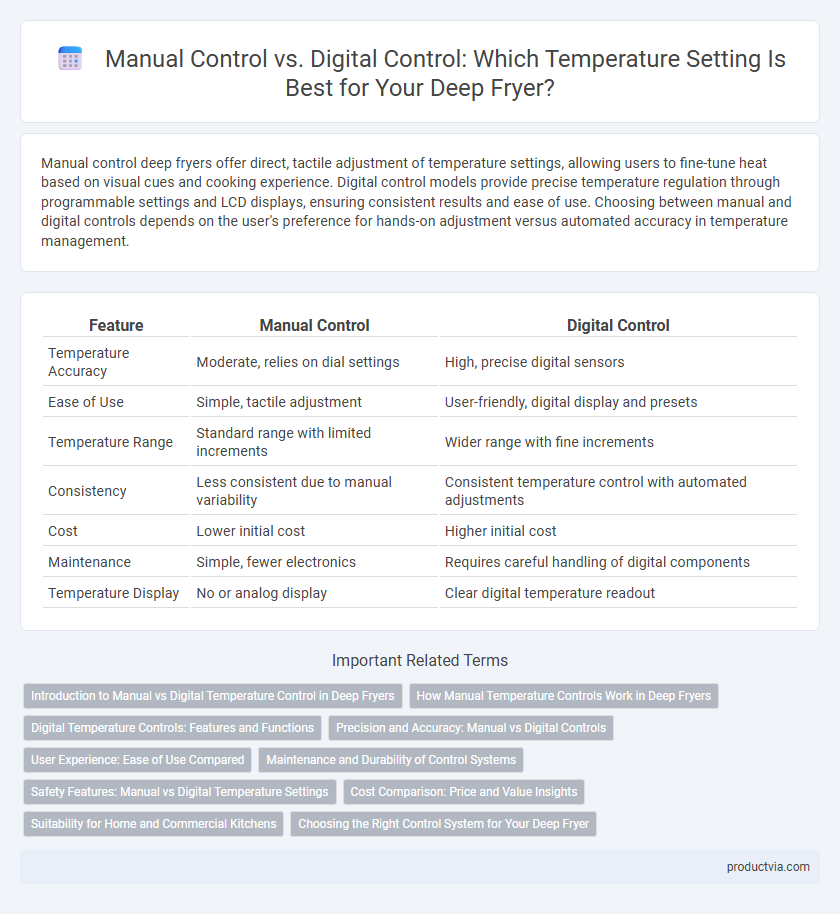Manual control deep fryers offer direct, tactile adjustment of temperature settings, allowing users to fine-tune heat based on visual cues and cooking experience. Digital control models provide precise temperature regulation through programmable settings and LCD displays, ensuring consistent results and ease of use. Choosing between manual and digital controls depends on the user's preference for hands-on adjustment versus automated accuracy in temperature management.
Table of Comparison
| Feature | Manual Control | Digital Control |
|---|---|---|
| Temperature Accuracy | Moderate, relies on dial settings | High, precise digital sensors |
| Ease of Use | Simple, tactile adjustment | User-friendly, digital display and presets |
| Temperature Range | Standard range with limited increments | Wider range with fine increments |
| Consistency | Less consistent due to manual variability | Consistent temperature control with automated adjustments |
| Cost | Lower initial cost | Higher initial cost |
| Maintenance | Simple, fewer electronics | Requires careful handling of digital components |
| Temperature Display | No or analog display | Clear digital temperature readout |
Introduction to Manual vs Digital Temperature Control in Deep Fryers
Manual temperature control in deep fryers relies on a physical dial or knob, offering straightforward adjustment but limited precision and repeatability. Digital temperature control uses electronic sensors and displays to provide accurate, programmable settings, ensuring consistent frying results and enhanced safety. Choosing between manual and digital controls depends on the desired balance of cost, ease of use, and temperature accuracy.
How Manual Temperature Controls Work in Deep Fryers
Manual temperature controls in deep fryers operate through a simple thermostat dial that adjusts the heating element based on the set temperature. This mechanical control relies on a bimetallic strip or sensor to open and close the electrical circuit, maintaining consistent oil temperature without digital sensors. Users benefit from straightforward, reliable operation and quick adjustments but may experience less precise temperature regulation compared to digital controls.
Digital Temperature Controls: Features and Functions
Digital temperature controls in deep fryers offer precise and consistent heat regulation through advanced sensors and programmable settings, enhancing cooking accuracy and energy efficiency. Features such as LCD displays, preset temperature profiles, and real-time temperature monitoring provide users with greater control and customization for various frying tasks. These controls also enable automatic temperature adjustments and alerts, reducing the risk of overheating and improving overall safety and cooking results.
Precision and Accuracy: Manual vs Digital Controls
Digital controls in deep fryers offer superior precision and accuracy in temperature settings compared to manual controls, allowing consistent heat regulation within narrow tolerances. Manual controls rely on analog adjustments, leading to potential variability and less exact temperature maintenance, which can affect cooking outcomes. The precise temperature stability of digital systems ensures optimal frying results and energy efficiency.
User Experience: Ease of Use Compared
Manual control deep fryers provide tactile dials that allow precise temperature adjustments but may require more attention to maintain consistent heat. Digital control fryers feature programmable settings and digital displays, enhancing accuracy and simplifying repetitive tasks for users. Many users find digital controls easier to use due to clear temperature feedback and preset options, improving overall user experience.
Maintenance and Durability of Control Systems
Manual control systems in deep fryers feature straightforward mechanical components that are less prone to electronic failures, resulting in easier and more cost-effective maintenance. Digital control systems offer precise temperature regulation but may require specialized servicing and are susceptible to issues from moisture or electrical surges. Durability of manual controls tends to surpass digital ones in high-use or harsh kitchen environments due to their simpler design and fewer sensitive parts.
Safety Features: Manual vs Digital Temperature Settings
Manual control deep fryers rely on analog thermostats, which provide reliable but less precise temperature regulation, potentially increasing the risk of overheating or oil degradation. Digital control systems offer accurate temperature settings with built-in safety features such as automatic shutoff and temperature alerts that minimize hazards and maintain consistent cooking conditions. Advanced digital controls enhance safety by reducing human error and ensuring optimal frying temperatures through real-time monitoring and adjustments.
Cost Comparison: Price and Value Insights
Manual control deep fryers typically cost less upfront, offering basic temperature adjustment through knobs and dials, making them suitable for budget-conscious users. Digital control models demand a higher initial investment but provide precise temperature regulation, programmable settings, and energy efficiency, potentially reducing operational costs over time. Evaluating price against value, digital controls justify the premium for commercial kitchens requiring accuracy and consistency, while manual controls remain favored in smaller or less frequent frying applications.
Suitability for Home and Commercial Kitchens
Manual control deep fryers offer straightforward temperature adjustment suitable for home kitchens where simplicity and cost-effectiveness are priorities. Digital control deep fryers provide precise temperature settings and programmable features ideal for commercial kitchens requiring consistent cooking results and efficiency. The choice depends on the need for accuracy and volume; digital controls excel in busy environments, while manual controls suit occasional domestic use.
Choosing the Right Control System for Your Deep Fryer
Manual control systems in deep fryers offer straightforward, tactile adjustments for precise temperature settings, ideal for cooks preferring hands-on control and simplicity. Digital control systems provide programmable temperature accuracy, real-time monitoring, and enhanced consistency, benefiting professional kitchens requiring precise frying conditions. Selecting the right system depends on user preference, kitchen environment, and the need for temperature precision and repeatability in frying processes.
Manual control vs Digital control for temperature settings Infographic

 productvia.com
productvia.com